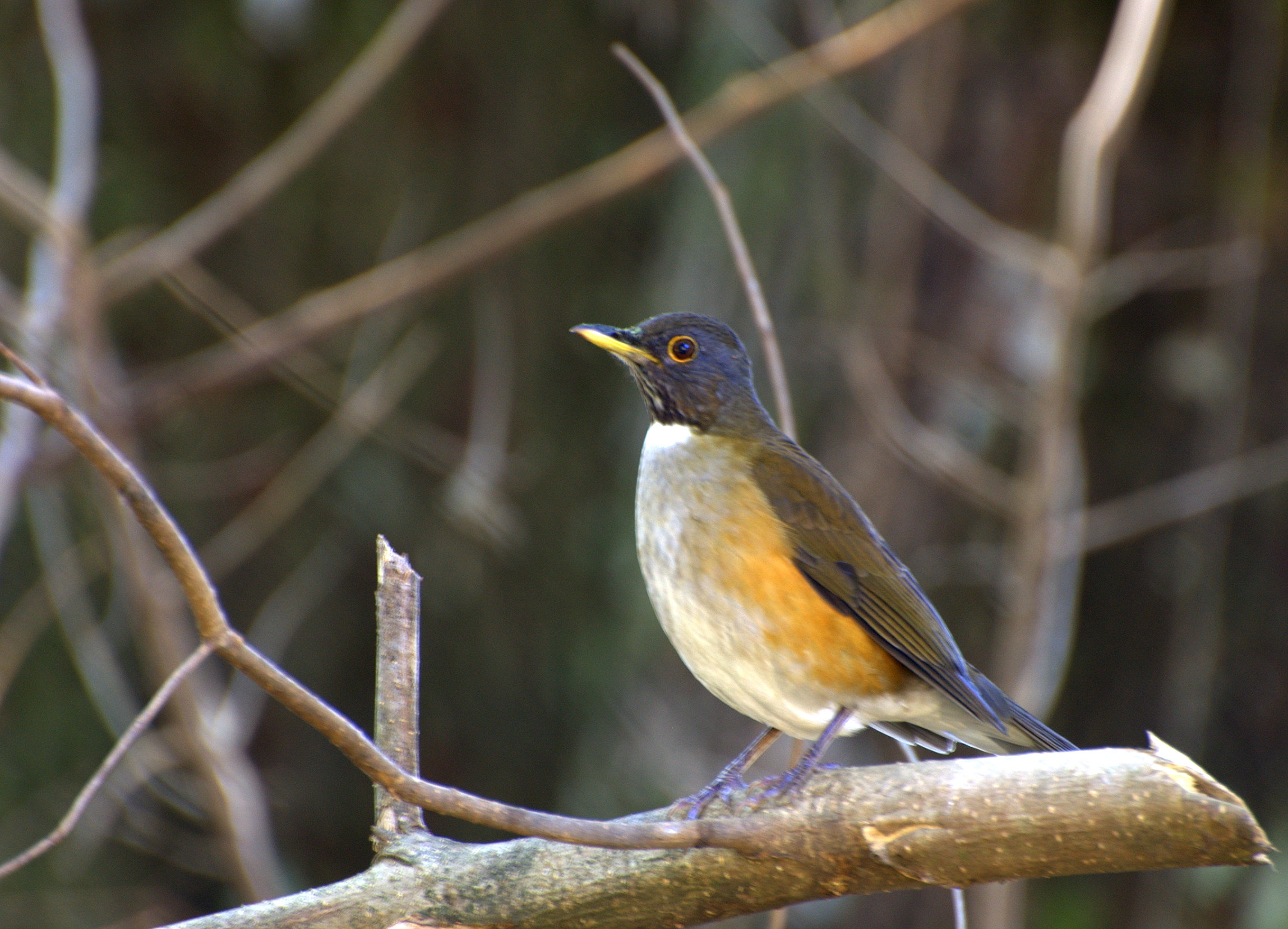- White-necked Thrush
Taxobox
name = White-necked Thrush

image_caption = "Turdus a. albicollis"
status = LC
status_system = iucn3.1
regnum =Animalia
phylum =Chordata
classis =Aves
subclassis =Neornithes
infraclassis =Neognathae
superordo =Neoaves
ordo =Passeriformes
subordo =Passeri
infraordo =Passerida
superfamilia =Muscicapoidea
familia =Turdidae
genus = "Turdus "
species = "T. albicollis"
binomial = "Turdus albicollis"
binomial_authority = Vieillot,1816 The White-necked Thrush ("Turdus albicollis") is a
songbird found in forest and woodland inSouth America . Thetaxonomy is potentially confusing, and it sometimes includes the members of the "T. assimilis" group assubspecies , in which case the "combined species" is referred to as the White-throated Thrush (a name limited to "T. assimilis" when the two are split). On the contrary, it may be split into two species, the Rufous-flanked Thrush ("T. albicollis") and the Grey-flanked Thrush ("T. phaeopygos").Description
This thrush is 20½-26 cm (8-10 in) long and weighs 40-77 g (1.4-2.7 oz).Collar (2005)] The upperparts are dark brown, turning duskier or greyer towards the ocular region. The throat is white with dense dark streaks, except on the lowermost part, resulting in the appearance of a white crescent below the dark-streaked white throat. This has given rise to both its English and
scientific name . The crissum and central belly are whitish, and the chest is grey often tinged brown. The members of the nominate group have conspicuous rufous flanks, and the bill is yellow with a duskyculmen . The flanks are paler and more tawny in the subspecies "crotopezus", which also has the entire upper mandible dusky. The members of the "phaeopygos" group lack contrasting rufous or tawny flanks, and have bills that are almost entirely dusky. All subspecies have pinkish-brown legs and a reddish or yellow eye-ring. Sexes are similar, but juveniles are duller, with dull orange spotting above, and brownish spotting below. [Restall "et al" (2006)]The song is a relatively musical, often rather monotonousHilty (2003)] "two-e-o, two-e". The calls is a distinctive "wuk", while the alarm is a rough "jjig-wig-wig".
Distribution and habitat
The nominate group (including subspecies "paraguayensis" and "crotopezus") occurs in eastern
Brazil , far northernUruguay , easternParaguay and far north-easternArgentina . The "phaeopygos" group (including subspecies "phaopygoides", "spodiolaemus" and "contemptus") is mainly found in theAmazon Basin , but with populations extending along the eastern slope of theAndes as far south as north-eastern Argentina, and as far north as westernVenezuela , with extensions along the Coastal Range, the region centered aroundSerranía del Perijá andSierra Nevada de Santa Marta , and the islands ofTrinidad and Tobago .Both groups are mainly associated with humid forest and woodland. In the case of the nominate group, mainly the
Atlantic Forest , and in the case of the "phaeopygos" group, mainly theAmazon Rainforest or humid forests and woodlands near mountains. It rarely ventures far from cover.Behavior
The White-necked Thrush mainly feeds on or near the ground on
invertebrate s. It also takes somefruit and berries. It regularly followsarmy ant swarms, but does not attendmixed species flock s. Throughout most of its range, especially in the Amazon, it is a shy species, heard far more than seen, but inTrinidad and parts of south-eastern Brazil it may be less retiring.The nest is a lined cup of twigs placed low (at a height of 1-9 m [3-30 ft] ) in a tree or bush. Two to three reddish-blotched green-blue eggs are laid and incubated by the female alone for 12-13 days.
Taxonomy
"T. albicollis" sometimes includes the members of the "T. assimilis" group as subspecies, in which case the "combined species" is referred to as the White-throated Thrush (a name limited to "T. assimilis" when the two are split). Published evidence supporting either treatment is weak, but most recent authorities have followed the split. [Remsen "et al." (2008)]
On the contrary, it has been suggested that the nominate group and the "phaeopygos" group of "T. albicollis" should be considered separate species, but the voices of the two are similar, and the subspecies "crotopezus" from the nominate group approach members of the "phaeopygos" group in both plumage and colour of bill.Ridgely & Greenfield (1989)] If the two groups are split, the
common name Rufous-flanked Thrush has been suggested for "T. albicollis", with "T. phaeopygos" retaining the common name White-necked Thrush or being renamed Grey-flanked Thrush.Footnotes
References
*|year=2004|id=51637|title=Turdus albicollis|downloaded=12 May 2006 Database entry includes justification for why this species is of least concern
* (2000): "Thrushes". Christopher Helm, London. ISBN 0-7136-3940-7
* Collar, N. J. (2005). White-throated Thrush (Turdus albicollis). Pp. 663 in: del Hoyo, J.; Elliott, A.; & Christie, D. A. eds. (2005). "Handbook of the Birds of the World." Vol. 10. Cuckoo-shrikes to Thrushes. Lynx Edicion, Barcelona. ISBN 84-87334-72-5
* (1991): "A guide to the birds of Trinidad and Tobago" (2nd edition). Comstock Publishing, Ithaca, N.Y.. ISBN 0-8014-9792-2
* (2004): Notes on breeding birds from an Ecuadorian lowland forest. "Bull. B.O.C." 124(1): 28-37. [http://depts.washington.edu/nhrg/Greeney,%20Gelis%20%26%20White%202004.pdf PDF fulltext]
* (2003): "Birds of Venezuela". Christopher Helm, London. ISBN 0-7136-6418-5
* Remsen, J. V., Jr.; Cadena, C. D.; Jaramillo, A.; Nores, M.; Pacheco, J. F.; Robbins, M. B.; Schulenberg, T. S.; Stiles, F. G.; Stotz, D. F.; & Zimmer, K. J. (2008). [http://www.museum.lsu.edu/~Remsen/SACCBaseline.html A classification of the bird species of South America.] American Ornithologists' Union. Accessed2008-08-07
* (2006): "Birds of Northern South America". Christopher Helm, London. ISBN 0-7136-7243-9 (vol. 1). ISBN 0-7136-7242-0 (vol. 2).
* (1989): "The Birds of South America - The Oscine Passerines (vol. 1)." Oxford University Press, Oxford. ISBN 0-19-857217-4External links
* [http://ibc.hbw.com/ibc/phtml/especie.phtml?idEspecie=5986 "Turdus albicollis", "White-necked Robin" videos] on the Internet Bird Collection
* [http://vireo.acnatsci.org/search.html?Form=Search&SEARCHBY=Scientific&KEYWORDS=turdus+albicollis&showwhat=images&AGE=All&SEX=All&ACT=All&Search=Search&VIEW=All&ORIENTATION=All&RESULTS=24 White-necked Thrush photo gallery] VIREO [http://vireo.acnatsci.org/species_image.php?species=Turdus+albicollis Photo-High Res]
* [http://www.arthurgrosset.com/sabirds/photos/turalb15136.jpgPhoto-High Res] ; [http://www.arthurgrosset.com/sabirds/white-neckedthrush.html Article & synopsis] arthurgrosset
* [http://www.oiseaux.net/oiseaux/passeriformes/images/merle.a.col.blanc.jefe.1g.jpgPhoto-High Res] ; [http://www.oiseaux.net/photos/jean-michel.fenerole/merle.a.col.blanc.1.html Article] oiseaux
Wikimedia Foundation. 2010.
